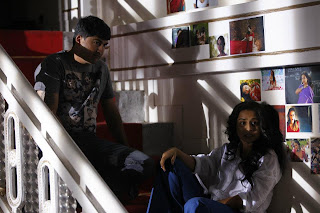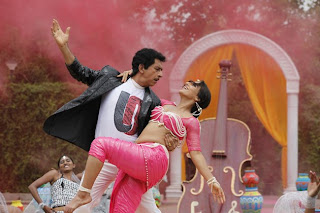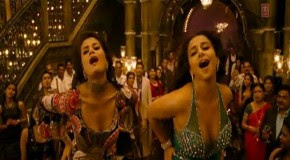Making of The Dirty Picture
Cinematographer Bobby Singh shares his insights on one of the most talked about movies in Indian cinema, “The Dirty Picture,” over a cup of coffee at Adlabs cafeteria.
The Dirty Picture revolves around the life and times of Silk Smitha, tracing her journey from village life to a world filled with glamour. It depicts how Silk enters this new world where she transforms into, not a conventional heroine per se, but an Item Girl. The main characters are Silk (Vidhya Balan), Suryakanth (Naseeruddin Shah), Abraham (Emraan Hashmi), Ramakanth (Tusshar Kapoor) and Nyla (Anju Mahendru). The story deals with the protagonist’s life and also focuses on the men within it. Bobby explains, “It took 65 days spread over 4 or 5 months to shoot. The process was a bit complicated as we had 3 very specific looks in the movie and obviously while filming one can’t say, ‘I would like to shoot this phase first and the other second,’ so we would shoot 2 scenes from 2 different phases. It took us time to do the change over”.
 He further reveals, “The movie has an 80’s look to it. The simplest thing that we could have done to achieve that look was to add a sepia filter but we didn’t opt for the simplest way out. Movies that were made in those days were a bit tacky. The idea was to make a period film that had the flavor of the 80’s but at the same time didn’t give the movie an overall tawdry look. In those days the negative used to have a specific look and so I wanted to replicate it. It was an interesting exercise where Priya Suhas (Production Designer), Niharika Khan (Costume Designer) and the actors helped tremendously. The approach was simple. In the first half we had to make her look ordinary and then later transform her into a gorgeous woman where the men would be lusting for her. The final phase was her downfall. I was very clear that although she is falling from grace, she had to look beautiful and sensual. We achieved that with make up by placing pads inside her mouth making her appear bloated. She was a star so we had to showcase her within those elements. Milan Luthria is a great director to work with. He gives you a lot of freedom and doesn’t interfere after everything has been discussed. It made the job easy”.
He further reveals, “The movie has an 80’s look to it. The simplest thing that we could have done to achieve that look was to add a sepia filter but we didn’t opt for the simplest way out. Movies that were made in those days were a bit tacky. The idea was to make a period film that had the flavor of the 80’s but at the same time didn’t give the movie an overall tawdry look. In those days the negative used to have a specific look and so I wanted to replicate it. It was an interesting exercise where Priya Suhas (Production Designer), Niharika Khan (Costume Designer) and the actors helped tremendously. The approach was simple. In the first half we had to make her look ordinary and then later transform her into a gorgeous woman where the men would be lusting for her. The final phase was her downfall. I was very clear that although she is falling from grace, she had to look beautiful and sensual. We achieved that with make up by placing pads inside her mouth making her appear bloated. She was a star so we had to showcase her within those elements. Milan Luthria is a great director to work with. He gives you a lot of freedom and doesn’t interfere after everything has been discussed. It made the job easy”. Bobby Singh’s philosophy in lighting is to start with the background rather than the foreground or subject. “When I light I hope to achieve something similar to what the writer was able to with his/her pen. Each scene has a discernible mood. I work with the ambient light entering the space first. In certain places we stylized the shots. I used a lot of china balls (with 500w and 200w clear bulbs) for lighting the face. We were shooting in Hyderabad and earlier in the film there were softies that were actually used in the 80’s and for a strange reason they stopped using them now. They are so much better than the 2k softies that we use in movies today. I used them throughout the film but as such I have not done anything special.”
During pre production Bobby sat down with Priya and Niharika to discuss the color palette and decided on all the elements they didn’t need in the film. Gradually they decided on the color of Silk’s clothes and the backgrounds based on the characterization. As Priya recalls, “We were aiming at a certain period in the late 70s and early 80s. It was probably the period where you would see two roses meet and that would signify kissing. Visually it was not very appealing so I had to do something that would make it appealing and still fit the period.There were four different stages in the film – The beginning, the 2nd phase when she was trying to make a mark followed by the 3rd phase that was the centered around glamour and the final phase where she was under the influence of drugs and alcohol”. She continues, “As far as colors we began the film with dull backdrops. The colors were muted. For the glamorous phases we used bright white and gold. During her downfall the palette changed to dark grey and green”.
Regarding set design, Priya said, “One of the challenges was to reconstruct certain sets and make it look like 1980’s Madras when it was not Chennai. The predominant aspect was to get the hoardings made when they were not printed but just painted. No acrylic or vinyl boards were used. We had an actual location that I converted into a madras street in film city.”
Silks house was a ready-made set. They indicated that one of the biggest challenges was to achieve the glamour elements and simultaneously deliver the different phases from her high point to the period where she was dying. They had to keep in mind what a person would go through when facing such mental stress.
Priya continues “Procuring props was quite stressful as my department was working around the clock and Milan never said no to me. He helped me a lot. Capturing the period was challenging. The idea was to achieve something people would relate to. We tried to achieve a mix between the Himmatwala (1983) and Moulin Rouge (2001). It would be restricted to the exterior but that is what we were working around. We started with Himmatwala then narrowed it down to Qurbaani. They were the predominant references”.
Naseeruddin Shah played a superstar so lavish spaces were created for him. “We watched a lot of 80s films for references, many of which were quite bad but we began to choose what we wanted and extracted the subtleties. We shot a lot at Ramoji studio, a perfect location. A lot of filming was also done in Film City. Priya converted a lot of Balaji’s existing sets by bringing in property and painting it accordingly. On some sets she would use wallpaper and practical lamps.”
Priya notes, “The Himmatwala song for this movie was very difficult but we got lucky to end up in Ramoji studio. We used their existing props, as it would have been costly to fabricate props in Mumbai”. There was a run down room in Killick Nixon Studios in Mumbai that Priya and her team converted into the space where silk lives when she is in chawl.

Bobby adds, “The ‘oh la la’ song featured 20 different locations and was shot in 3 days. Pony Verma (choreographer) and I kept jumping from location to location and if there was something we liked after completing a shot we would just move on. We were quite spontaneous. The crew went ballistic. It was shot all over the place. The song ‘Ishq suffiani’ was shot in Bidar, Old Fort, Karnataka and the Andra Pradesh border. It was suppose to be a dream sequence and since I had shot the whole film with a coral filter I made it look a little different by infusing some Cyan. Niharika designed clothes that complemented the tone. Imran wore blue and black. Vidya wore red. It was quite stylized. As far as the production it was quite crazy because every morning we would have 20,000 people waiting to watch the shoot. Controlling the crowd was a hassle”.
Bobby recalled a location they all thought was jinxed. He comments, “Milan still laughs about it. We had a one day shoot scheduled and for some odd reason ended up shooting in patches for over 3 days. It is the location where Nyla throws a party and Vidya becomes a big star. She ends up dancing on the road and people gather around. There is a huge traffic jam. We shot this scene in Hyderabad on a straight road that stretches for a kilometer. We virtually lit the entire road. We had about 600 – 700 kW of lights. It rained forcing us to come back the next day. Something happened again and we had to wrap without shooting. After a month we went there again and used a lot of 5Ks, Multis, and softies. I used a coral filter on the camera so that during the digital intermediate (DI) I was just balancing the image. The information in the negative was already there so the colorists just needed to enhance it.We did a test before we started shooting and my colorists Nilesh agreed on using the filter as it did something to the skin and not the entire image. If we did the same effect in post it would have affected the whole image. This would have been time consuming to remove and finesse. Everything was done while filming in camera. If there was something I couldn’t have done during principle photography it was omitted. I didn’t leave anything for post. I used many filters on my lights as well. The colorists just refined the extra gloss on the image and crushed the blacks here and there.”
 “Honeymoon ki raat” song was shot in Mumbai. I used 5k softies along with space lights wrapped with a 40*40 grid cloth. Bobby smilingly confesses, “I usually went with the flow and followed my heart rather than my mind. Logistics take place in my mind but the final call is from the heart.”
“Honeymoon ki raat” song was shot in Mumbai. I used 5k softies along with space lights wrapped with a 40*40 grid cloth. Bobby smilingly confesses, “I usually went with the flow and followed my heart rather than my mind. Logistics take place in my mind but the final call is from the heart.” Devandra Dash (Steadicam operator) was used for certain sequences, as he wanted the camera to float around the characters and environment. For framing he stayed away from the 80’s style where characters were placed in the center. He comments, “Things in general don’t look as nice.” With Vidya he kept a practical in the background to give her a glamorous glow. For dance sequences multiple cameras were used. “I was operating one, another went on a jib and sometimes Milan operated which he did very well. My good friend Mujahid Raza did second unit / additional photography on the film,” Bobby explained.
Lenses: Ultra primes and Optimo zoom
Camera: 435
My team: 1st AC – Kalyani Kut, 2ndAC – Karm Chawla, Gaffer – Rakaa, Focus puller- Gajanand Mutgekar
Light company: Blitz
Film stock: Kodak “I was looking for a particular tone and am quite happy with the stock. I used vision 250D and 500T. Kodak just has nicer skin tones and with the coral filter it brought out a desirable bronze quality.”
Perf – 3 perf , 2nd camera – 4 perf
Making of The Dirty Picture
Tags
Lighting Milan Luthria Bollywood Priya Suhas Indian cinema Making Niharika Khan Ultra Primes Arri Bobby Singh Dirty Picture movies
Submit a Comment
